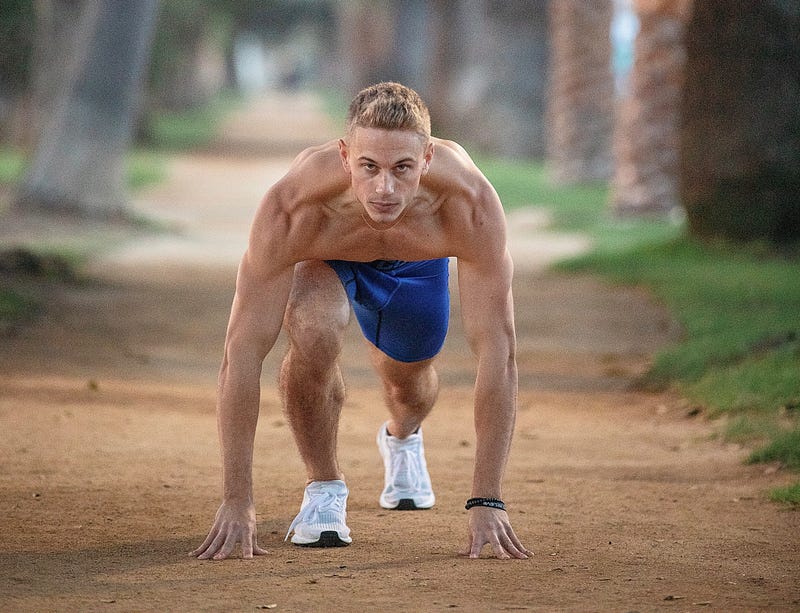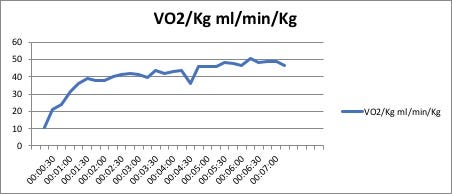There are better measures to predict endurance performance

The V02 max test is a measure of the maximum amount of oxygen our body can use during intense exercise. The test is brutal and pushes the athlete to their absolute, physical limits over a short, but increasingly difficult, performance.
The V02 max test, is a measure, during maximal exercise, of the highest rate that oxygen is consumed by the mitochondria of the body. Mitochondria are the power cells of the body and, during a process known as oxidative phosphorylation, store energy chemically in small molecules called ATP.
The test is widely accepted as an indicative measure of an athlete’s aerobic fitness and is used to assess aerobic fitness, and as a guide for training sessions
For athletes and sports scientists, there are huge benefits to deciphering the factors and mechanisms that limit V02 max and understanding its role in endurance performance.
The classical view of maximal oxygen uptake was originally put forward by A.V Hill in the 1920s. It suggests V02 max is limited by the ability of our cardiorespiratory systems (heart, blood vessels, airways, and lungs) to deliver oxygen to working skeletal muscles.
According to Hill’s model, the body has both a physical and mechanical upper limit. An athlete’s performance is restricted as a result of any, or all, of the following :
- A low oxygen uptake — not enough oxygen coming into the body. These limitations could be environmental, i.e. low oxygen in the air, or physical
- A reduced upper limit of maximal oxygen uptake — an athlete’s V02 max is reduced, possibly due to lack of training and related physiological adaptations
- Increased oxygen requirements — the athlete needs more oxygen, possibly due to physiological limitations resulting from inheritance or training
How do we measure V02 max?
V02 max can be determined through a number of aerobic tests that activate the larger muscle groups. The aim of the test is to maximise the aerobic energy transfer using appropriate exercise intensity and duration.
Testing tends to be performed within the lab — as the equipment is bulky and expensive — and involves a continuous, supramaximal (above what a runner would normally consider being their maximum effort) exercise challenge.
A treadmill or a stationary cycle is normally used, and involves increasingly difficult increments (speed or incline), until the participant reaches volitional exhaustion. At this point, the muscles are apparently exhausted and the runner ‘chooses’ to stop.
The scores differ, for each athlete, depending on the mode of exercise — the muscle fibers and groups recruited — with a treadmill usually giving the highest values.
The challenge for the lab is to ensure that the test protocol is sufficiently long to reach a plateau, whilst increasing the load quickly to ensure other mechanisms of fatigue do not cause the participant to stop the test early.
There are a number of objective measures to ensure a V02 max has truly been reached.
The athlete’s results include:
- A V02 that no longer increases despite an increasing load i.e. speed, or incline

- A heart rate is reached that is within 10 beats of the maximum heart rate
- A respiratory exchange ratio greater than 1.15. This is a comparison of carbon dioxide produced versus the oxygen used.
- A rating of perceived exertion above 17 on the Borg scale. This is a subjective view, by the athlete, of how hard they are working during the test (17 is ‘very hard’, and it increases to ‘extremely hard’ and ‘maximal exertion’).
Where the criteria are either partially, or not at all, met, the term peak oxygen consumption (V02 peak) is adopted rather than V02 max.
Appraisal of the V02 max test
A large amount of sports science research has confirmed the value of measuring maximal aerobic uptake and there is a clear difference in scores between the aerobically trained and untrained.
However, concerns have been raised regarding the effectiveness of the test and suggestions that the psychology of the participant is likely to impact the outcome. This includes the level of discomfort, motivation, and perceived competence.
There have been more recent challenges from Noake’s ‘Central Governor Model’ and Marcora’s ‘Psychobiological model’ — see my related articlefor more detail.
Both models propose that the brain is an important contributing factor to our maximum oxygen uptake, and therefore the results of the V02 max test.

Does the V02 test predict endurance performance?
Probably not…
Despite a large number of training methods and approaches that place a huge reliance on the outcome of the V02 max test, doubts have been raised regarding its ability to predict success in endurance events.
Over the last decade, a number of investigations have explored, with conflicting results, maximal oxygen uptake and its ability to predict completion or performance within ultra-marathon events:
- A study of mountain runners suggested that race times were not related to cardiorespiratory fitness measures but instead were consistent with individual pacing strategies, variations in recovery between stages, and possible factors not measured, including genetics, nutrition training, and psychology.
- In a study of ultra-marathoners running as far as possible in 24 hours, it was determined that a high V02 maxdid not predict the running distance achieved. Instead, other factors including pacing, nutrition and motivation appeared to be better predictors of success.
- Research reported, age, anthropometric characteristics (body mass index, limb circumference), and training characteristics including running speed, training volume and prior race experience, were better predictors of race success.
What can we replace the V02 max test with?
Challenges to the classical model of maximal aerobic uptake, and research findings, indicate that the V02 max test may be inadequate to measure endurance performance.
In response, other factors and measures have been explored.
Lactate threshold (LT), also known as the lactate inflection point, has become an important indicator of endurance performance, and research suggests more indicative of endurance performance than V02 max.
Considerable research data, with a focus on runners, has provided evidence that a lower blood lactate concentration, at a given workload, is linked to aerobic endurance performance, and is frequently used to measure the status of aerobic training, and to prescribe training intensities.
What predicts race success?
A growing body of literature investigating the multiple factors involved in sporting success in endurance racing has postulated that performance in events is a product of both maximal sustained power output and, the energy cost of maintaining speed.
Research has identified three physiological attributes that contribute to successful performance in distance running:
- A high cardiac output and oxygen delivery to working muscles, identified as the V02 max
- The ability to maintain a high percentage of V02 maxfor the longest time possible
- The ability to move economically, known as running economy.
Running economy(RE) is a measure of energy demanded (in response to the interaction of biomechanical and physiological factors) to run at a given running velocity — in other words, a sub-maximal V02.
RE explains, in part, the performance differences between athletes of comparable V02 max. Indeed, trained, as opposed to untrained, runners can be recognised through an improved RE.
Improved efficiency is likely to be in response to a number of adaptations, including the ability of muscles to use oxygen, bio-mechanical changes, and an increase in red blood cells.
Studies into both short and long-term interventions have reported that uphill, and high intensity running on flat-ground, alongside plyometric and strength training, result in increased running economy. This adaptation may be in response to improved neuromuscular activity, increased musculo-tendinous stiffness, and the conversion of some fast-twitch fibers to more fatigue-resistance fibers.
The future for endurance research
The benefits of improved running economy are very clear. Positive changes to running economy reflect improved oxygen consumption and are likely to be accompanied by an increased long-term endurance, brought about by delaying fatigue, enhanced anaerobic capacity, and an improved maximal speed.
Indeed, running economy has been recognised as a key factor in success at races up to marathon distance, but limited research has been undertaken to better understand its role in ultra-marathon running. As a result, agreement has not been reached regarding the most economical running technique, or whether improved RE, in response to training for an ultra-marathon, benefits, or predicts, endurance performance during competition.
Running economy should not be viewed in isolation but must be considered as an important psychophysiological factor, along with motivation, mental toughness and personality.
Further interdisciplinary research is warranted in a combination of kinetic, neuromuscular, genetic, and anatomical factors.
Key References
See also, within medium: deliberate practice, limits of endurance, adaptation, mental toughness, evolutionary endurance
Bassett, D. R. (2000). Limiting factors for maximum oxygen uptake and determinants of endurance performance. Medicine & Science in Sports & Exercise,70.
Hill, A. V., Long, C. N. H & Lupton, H. (1924). Muscular exercise, lactic acid and the supply and utilisation of oxygen: Parts VII-VIII. Proc. Roy. Soc.B 97:155–176, 1924.
Knechtle, B. (2012). Ultramarathon Runners: Nature or Nurture? International Journal of Sports Physiology and Performance, 7(4), 310–312.
Knechtle, B., Rosemann, T., Knechtle, P., & Lepers, R. (2010). Predictor Variables for A 100-km Race Time in Male Ultra-Marathoners. Perceptual and Motor Skills, 111(3), 681–693.
Marcora, S. M. (2008). Do we really need a central governor to explain brain regulation of exercise performance? European Journal of Applied Physiology,104(5), 929–931.
Noakes, T. D. (2007). The Central Governor Model of Exercise Regulation Applied to the Marathon. Sports Medicine, 37(4), 374–377.
Noakes, T. D, St Clair Gibson, A. (2004) Logical limitations to the “catastrophe” models of fatigue during exercise in humans. British Journal of Sports Medicine, 38(5), 648–649.
Recent Comments